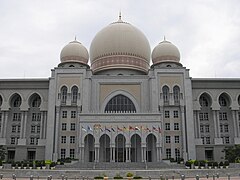Palace of Justice, Putrajaya
| Palace of Justice | |
|---|---|
| Istana Kehakiman استان كهكيمن |
|
 |
|
| General information | |
| Status | Complete |
| Type | Federal Court |
| Architectural style |
Islamic Moorish Palladian and Neoclassicism |
| Town or city |
Putrajaya Federal Territory |
| Country | Malaysia |
| Groundbreaking | 1999 |
| Construction started | 2000 |
| Completed | 2003 |
| Inaugurated | 2004 |
| Technical details | |
| Floor count | 5 |
| Design and construction | |
| Architect | aQidea Architect, AR Ahmad Rozi A Wahab |
The Palace of Justice (Malay: Istana Kehakiman; Jawi: ايستان كهكيمن) houses the Malaysian Court of Appeal and Federal Court, which moved to Putrajaya from the Sultan Abdul Samad Building in Kuala Lumpur in the early 2000s.
Due to the need for a proper office of the head of the Judicial system in Malaysia, a location within the Precinct 3 of Putrajaya was identified for this purpose. aQidea Architect was once again called to be commissioned to design the building after finishing the Prime Ministers Office not far from the Palace of Justice. It has 2 Appeal Courts and 6 Federal courts which has intricate network of passages segregating the Judges, witnesses, public, and the accused leading to the courts right from the car park or area of arrival. This is for the safety and security of everyone involved in order to achieve the desired courts functions and ambiance. The design is about bringing about "Order" and order is the theme of the day as the layouts are fashioned in an orderly manner, right from the smallest of rooms to the biggest and from the public realm to the private domain. AR Ahmad Rozi Abd Wahab, the principal Architect was personally responsible for the design layout and coming out with the architectural concept and ideas.
The Palace of Justice's design incorporates influences of Classical Islamic culture like Taj Mahal in India, Moorish culture, like the Sultan Abdul Samad Building in Kuala Lumpur and Western Classical influence, like Palladian. The classical design gives depths to the building skin and creates interesting articulated facade.
The complex comprises a five-storey building for the judiciary and a two-storey building to house the courts and offices.
There is a large central atrium (Rotunda) around which the various rooms are arranged. The atrium helps to guide visitors who had just arrived into the building and has clear visual connection to the other floors above.
...
Wikipedia
